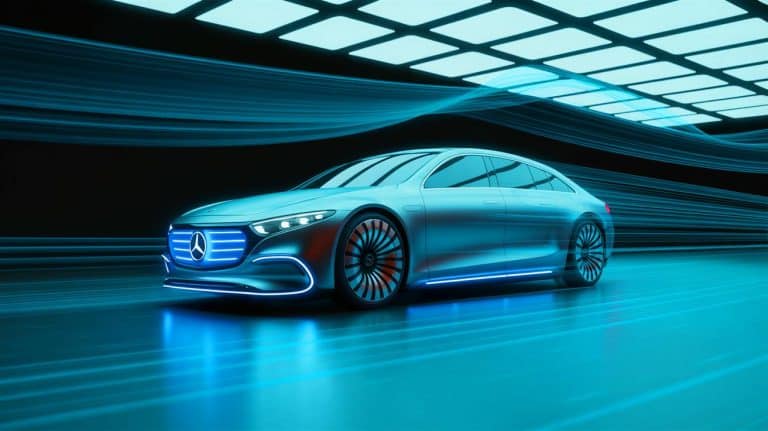| IN A NUTSHELL |
|
Mercedes-Benz, a pioneer in automotive engineering, has long been at the forefront of aerodynamic innovation. The company’s commitment to enhancing vehicle efficiency and comfort is exemplified by its latest developments in electric vehicle (EV) technology. By focusing on reducing the drag coefficient of their vehicles, Mercedes-Benz has succeeded in extending the driving range and improving the overall driving experience. This dedication is evident in their recent advancements, particularly in the electric CLA model, which demonstrates the brand’s ongoing pursuit of engineering excellence.
Historical Pursuit of Aerodynamic Efficiency
Mercedes-Benz’s journey toward aerodynamic excellence dates back to the 1930s, with the pioneering work of Wunibald Kamm, who introduced the “Kammback” designs. These innovations laid the foundation for the company’s ongoing efforts to minimize air resistance. The establishment of Mercedes-Benz’s first full-size wind tunnel in 1943 marked a significant milestone in the brand’s commitment to refining vehicle aerodynamics. This facility continues to be instrumental in testing airflow and other aerodynamic factors.
In response to the oil crisis of the late 1970s, Mercedes-Benz intensified its focus on fuel efficiency. This led to the development of vehicles like the S-Class W126 and the E-Class W124, which set new standards for aerodynamic performance. The W124, in particular, was noteworthy for being the first production model with a drag coefficient (Cd) under 0.30. These advancements paved the way for subsequent record-setting vehicles, including the 1938 W125 “Streamliner” and the 1978 C111-III diesel, which achieved remarkable drag coefficients and set numerous world records.
Innovations in Electric Vehicle Design
The evolution of electric vehicles has prompted Mercedes-Benz to further enhance its aerodynamic capabilities. The introduction of the electric CLA model showcases the brand's dedication to optimizing airflow. Engineers have implemented various design elements, such as aerodynamic wheels with bicolored full covers, which help reduce drag more effectively than standard wheels. Additionally, the underbody design builds upon previous models like the EQS and EQE, offering nearly complete coverage and improved protection for suspension components.
Mercedes-Benz's commitment to refining aerodynamics extends to its concept vehicles as well. The VISION EQXX concept, for instance, achieves an impressive drag coefficient of 0.17, underscoring the brand's relentless pursuit of aerodynamic perfection. Other innovative designs, such as the AMG GT XX's "aerodynamics by wire" plasma system, continue to push the boundaries of what is possible in automotive engineering.
Enhancing Comfort Through Aeroacoustics
Beyond improving efficiency, Mercedes-Benz places a strong emphasis on enhancing cabin comfort through aeroacoustics. The brand's advanced facilities, such as the Sindelfingen aeroacoustic wind tunnel, play a crucial role in achieving this goal. Equipped with 350 microphones, the tunnel allows engineers to identify wind noise around critical areas like A-pillars and mirrors. This information is then used to refine vehicle designs, ensuring a quieter and more comfortable driving experience.
The use of psychoacoustic metrics, such as loudness and sharpness, helps engineers assess human perception of noise. By employing binaural artificial heads that replicate ear placement, Mercedes-Benz gains valuable insights into how various design changes impact cabin acoustics. These efforts not only improve comfort but also enhance safety and visibility by guiding adjustments to components like pillars and mirrors.
Comprehensive Testing Facilities
Mercedes-Benz's state-of-the-art testing facilities are integral to its aerodynamic advancements. The Sindelfingen aeroacoustic wind tunnel can simulate speeds of up to 165 mph, allowing for precise measurement of aerodynamic forces. Its climate-controlled tunnels, capable of recreating temperatures from -40°F to 140°F, facilitate comprehensive testing of prototypes under varying conditions.
In addition to vehicle testing, the Untertürkheim "Large Wind Tunnel" hosts a range of projects, from bobsleds to stadium roofs. This versatility underscores Mercedes-Benz's commitment to innovation across multiple domains. Tools like the "Tanja" dummy and 64-microphone arrays further enhance the brand's ability to improve both efficiency and cabin comfort.
The advancements made by Mercedes-Benz in aerodynamic engineering exemplify the brand's unwavering commitment to innovation and excellence. As the automotive industry continues to evolve, the pursuit of reduced drag and enhanced comfort remains a central focus for manufacturers. With the growing demand for more efficient and comfortable vehicles, how will other automakers respond to the challenges posed by aerodynamics in the electric age?
Did you like it? 4.5/5 (27)








Wow, Mercedes is really pushing the boundaries of what’s possible with car design! 🚗💨
Wow, defying physics? What’s next, flying cars? 😂
How exactly do they “defy physics”? Sounds like marketing hype to me. 😏
Really interesting read! How does this new aerodynamic tech affect the overall cost of the car?
Are these advancements going to be available in all models or just high-end ones?
Is the VISION EQXX going to be available for purchase soon? It sounds fascinating!
Mercedes keeps breaking boundaries. When can we expect these advancements in all models? 🚗💨
Mercedes-Benz has always been a leader in innovation. Excited to see what’s next!
I think other car manufacturers will have a hard time keeping up with this level of innovation.
How exactly do these improvements help with electric vehicle efficiency?
Did anyone else read this and think of Back to the Future cars? 😂
While impressive, I wonder if these changes are just marketing hype. Anyone else skeptical? 🤔
Do these advancements mean the cars will be more expensive?
What’s the impact of these changes on maintenance and repair costs?